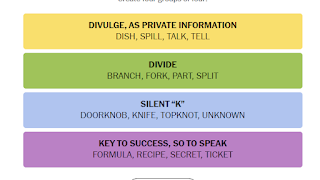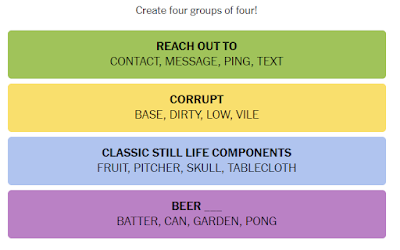NYT ‘Connections’ Hints and Answers Today, Tuesday, September 20
NYT ‘Connections’ Hints and Answers Today, Tuesday, September 5
NYT ‘Connections’ Hints and Answers Today, Tuesday, August 21
NYT ‘Connections’ Hints and Answers Today, Tuesday, August 12
NYT ‘Connections’ Hints and Answers Today, Tuesday, July 31
NYT ‘Connections’ Hints and Answers Today, Tuesday, July 12
NYT ‘Connections’ Hints and Answers Today, Tuesday, June 25
Hints for Today's NYT Connections Categories - Monday, June 25
NYT ‘Connections’ Hints and Answers Today, Wednesday, June 5th
Hints for Today's NYT Connections Categories - Wednesday, 5 June
NYT ‘Connections’ Hints and Answers Today, Sunday, May 28
Hints for Today's NYT Connections Categories - Friday, May 28
NYT ‘Connections’ Hints and Answers Today, Sunday, May 19
Hints for Today's NYT Connections Categories - Friday, May 19
NYT ‘Connections’ Hints and Answers Today, Friday, May 17
Hints for Today's NYT Connections Categories - Friday, May 17
Mastering New York Times Connections: Daily Solutions, Tips, and In-Depth Analysis
The New York Times Connections puzzle has become a popular challenge for puzzle enthusiasts. This engaging game requires players to identify connections among a set of words, presenting a delightful blend of strategy and knowledge. In this article, we will delve into daily solutions, offer tips and tricks for solving the puzzles efficiently, and provide an in-depth analysis of past puzzles to help you become a Connections master. Whether you're a novice or a seasoned player, this guide will enhance your puzzle-solving skills.
Daily Solutions for New York Times Connections
One of the most appealing aspects of the New York Times Connections puzzle is the daily challenge it presents. Each day, players are given a new set of words to analyze and connect. Finding the solutions can sometimes be straightforward, but often it requires a keen eye for detail and a strategic approach.
Understanding the Puzzle Format
The New York Times Connections puzzle typically provides a grid of words. Your task is to identify groups of words that share a common theme or connection. These connections can be based on various criteria, such as synonyms, antonyms, categories (e.g., animals, foods), or even more abstract relationships.
Steps to Solve Daily Puzzles
- Initial Scan: Start by scanning the list of words. Look for obvious connections and group them mentally.
- Create Categories: Group the words into potential categories. Write down or mentally note these groups.
- Cross-Check: Ensure that each word fits logically within a group. If a word doesn't fit, re-evaluate your categories.
- Finalize Connections: Once you have your groups, double-check for any remaining words and see if they fit into new or existing categories.
Example Solution
Consider a puzzle with the following words: Apple, Banana, Carrot, Dog, Elephant, Fox, Grape, Hound, Iguana, Jackfruit, Kiwi, Lemon.
- Fruits: Apple, Banana, Grape, Jackfruit, Kiwi, Lemon
- Animals: Dog, Elephant, Fox, Hound, Iguana
By grouping these words into fruits and animals, you solve the puzzle by identifying the connections.
Tips and Tricks for New York Times Connections
While solving the daily puzzles is fun, having a few tips and tricks up your sleeve can make the process even more enjoyable and efficient. Here are some strategies to help you master the New York Times Connections puzzles.
Familiarize Yourself with Common Themes
The more you play, the more you'll recognize recurring themes and categories. Common themes include:
- Colors: Words that are names of colors.
- Synonyms: Words that have similar meanings.
- Antonyms: Words that have opposite meanings.
- Categories: Groups like animals, fruits, countries, etc.
Use a Process of Elimination
If you're stuck, try eliminating words that don't fit into any obvious category. This can help narrow down the possibilities and make it easier to see the connections.
Look for Hidden Patterns
Sometimes, the connections are not immediately obvious. Look for hidden patterns such as:
- Letter Patterns: Words that start with the same letter or have similar letter sequences.
- Length of Words: Words of similar length might be connected.
- Cultural References: References to movies, books, historical events, etc.
Practice Makes Perfect
Like any skill, practice is crucial. The more you practice, the better you'll get at spotting connections quickly and accurately.
In-Depth Analysis of New York Times Connections Puzzles
To truly master the New York Times Connections puzzles, it's beneficial to analyze past puzzles. This analysis can reveal common themes and strategies that you can apply to future puzzles.
Common Themes in Past Puzzles
By examining past puzzles, we can identify several recurring themes. Here are a few examples:
- Geography: Countries, cities, rivers, mountains.
- Pop Culture: Movie titles, famous actors, song names.
- Food and Drink: Types of cuisine, ingredients, beverages.
- Historical Events: Significant dates, historical figures, wars.
Analyzing Puzzle Structure
Past puzzles often follow a certain structure. For instance, puzzles might include:
- Four categories with four words each: This is a common format, and knowing this can help you break down the puzzle more systematically.
- Overlapping Themes: Sometimes words might fit into more than one category, which adds a layer of complexity.
Example Analysis
Let’s analyze a sample past puzzle:
Words: Lion, Tiger, Bear, Wolf, Orange, Blue, Red, Green, Guitar, Piano, Drum, Flute, Pizza, Burger, Salad, Pasta.
- Animals: Lion, Tiger, Bear, Wolf
- Colors: Orange, Blue, Red, Green
- Musical Instruments: Guitar, Piano, Drum, Flute
- Foods: Pizza, Burger, Salad, Pasta
By categorizing these words, we see a clear structure with each category containing four words. Understanding this structure can help you approach future puzzles with a strategic mindset.
Patterns and Strategies
- Look for Non-Obvious Connections: Not all connections are straightforward. Some might require lateral thinking.
- Keep an Open Mind: Be open to different types of connections, including those that are less obvious or more abstract.
- Review and Reflect: After solving a puzzle, review the solution to understand why certain words were connected. Reflecting on your thought process can help improve your future performance.
The New York Times Connections puzzle is a delightful blend of challenge and fun, perfect for those who love word games and puzzles. By exploring daily solutions, utilizing tips and tricks, and analyzing past puzzles, you can sharpen your skills and enhance your enjoyment of the game. Remember, practice and patience are key. With each puzzle, you'll become more adept at spotting connections and thinking strategically.
Happy puzzling, and may your connections always be clear!
Understanding the Groups in the New York Times Connections Game: A Strategic Guide
The New York Times Connections game has quickly become a favorite among puzzle enthusiasts, offering a unique and intellectually stimulating challenge that goes beyond the typical word games. If you’ve ever found yourself immersed in the Connections game, you know that it’s not just about finding words—it’s about making connections between them. But what exactly are the groups in Connections, and how can you use this understanding to improve your gameplay? Let’s break it down.
What Are the Groups in the Connections Game?
In the New York Times Connections game, the objective is to identify groups of four words that share a common theme or category. These groups are the foundation of the game, and successfully identifying them is the key to winning. Each group you identify correctly brings you closer to solving the puzzle, but the challenge lies in figuring out which words belong together.
The Different Types of Groups
The beauty of the Connections game lies in its variety. The groups can range from the straightforward to the highly abstract, testing not just your vocabulary but also your ability to think laterally. Here are some common types of groups you might encounter:
Synonyms
- Example: Words that have similar meanings, like “happy,” “joyful,” “cheerful,” and “content.”
Antonyms
- Example: Words that are opposites, such as “hot,” “cold,” “bright,” and “dark.”
Categories
- Example: Words that belong to a specific category, like “apple,” “banana,” “orange,” and “grape” for fruits.
Homophones
- Example: Words that sound the same but have different meanings, such as “right,” “write,” “knight,” and “night.”
Wordplay
- Example: Groups that play on the meanings or sounds of words, like “bear” (the animal), “bare” (without covering), “barely” (scarcely), and “barrel” (a container).
Thematic Links
- Example: Words that are related by a common theme or cultural reference, such as “Batman,” “Superman,” “Wonder Woman,” and “The Flash” for superheroes.
Idioms or Phrases
- Example: Words that are part of common idioms or phrases, like “break,” “ice,” “leg,” and “ground” (as in “break the ice,” “break a leg,” etc.).
Letter Patterns
- Example: Words that share a specific letter pattern, such as all starting with the same letter or containing the same sequence of letters.
Number-Related Words
- Example: Words associated with numbers, such as “dozen,” “pair,” “trio,” and “quartet.”
Strategies for Identifying Groups
Successfully identifying the groups in the Connections game requires a mix of intuition, vocabulary knowledge, and strategic thinking. Here are some tips to help you improve your game:
Look for Obvious Connections First: Start with the words that seem to have the most straightforward connections. If you see a set of colors, fruits, or synonyms, group those together first to eliminate the easy options.
Consider Multiple Meanings: Words often have more than one meaning, so don’t get stuck on the first connection that comes to mind. A word like “bark” could relate to both trees and dogs, so think about all the possible connections.
Use Process of Elimination: If you’ve grouped some words together but are unsure about others, use the process of elimination. Narrow down your options by eliminating words that don’t fit with any of the remaining groups.
Think Creatively: Some connections might be less obvious and require creative thinking. Don’t be afraid to think outside the box—connections could be based on wordplay, cultural references, or even subtle thematic links.
Pay Attention to Word Length and Structure: Sometimes, the length or structure of a word can be a clue. For example, if you notice a group of four-letter words or words with a specific suffix, that might be a hint.
Revisit Unsolved Words: If you’re stuck, take a break and come back with fresh eyes. Often, the solution will become clearer after you’ve had a moment to reset your thinking.
Common Pitfalls to Avoid
While the Connections game is meant to be challenging, there are some common pitfalls that players should be aware of:
Overthinking: It’s easy to overanalyze the words and start seeing connections that aren’t really there. If you find yourself going down a rabbit hole, take a step back and reconsider the simpler options.
Ignoring the Obvious: Sometimes, the most obvious connections are the correct ones. Don’t dismiss a group just because it seems too easy—it might be exactly what you’re looking for.
Forgetting About Multiple Meanings: Remember that words can have multiple meanings. If a group doesn’t seem to make sense, consider alternative meanings of the words involved.
Getting Stuck on a Single Word: If one word is throwing off your groupings, try setting it aside and focusing on the others. Often, the troublesome word will fit into place once the other groups are sorted.
The Joy of Connections
The New York Times Connections game is not just a test of vocabulary—it’s a game of strategy, creativity, and lateral thinking. By understanding the different types of groups and how to identify them, you can enhance your gameplay and enjoy the challenge that Connections offers.
Whether you’re a seasoned player or just starting, the key to success lies in your ability to see beyond the obvious and explore the many ways words can be connected. So next time you sit down to play, remember these tips and strategies, and you’ll be well on your way to becoming a Connections master.
Happy puzzling!























0 Comments